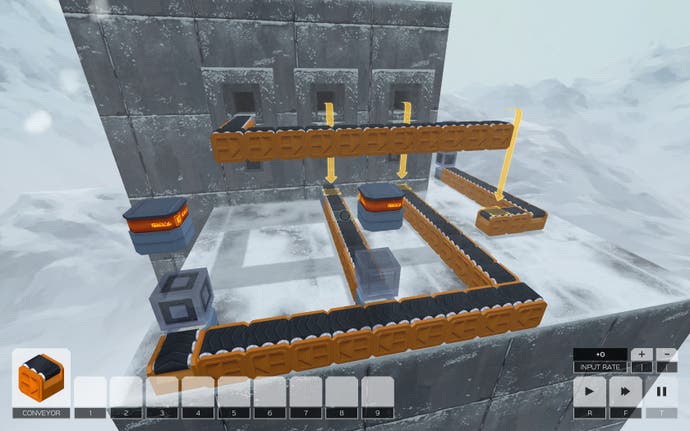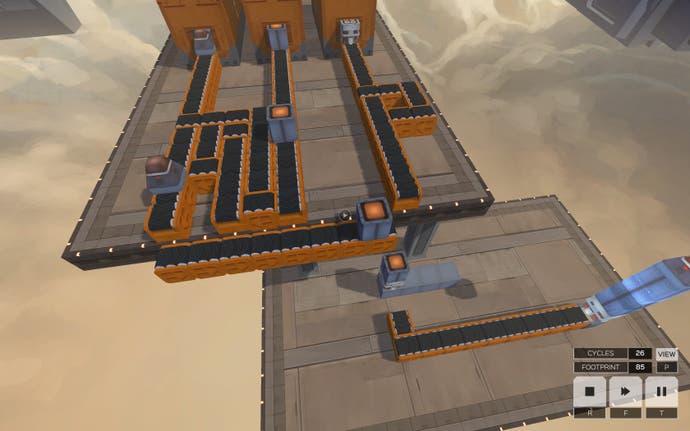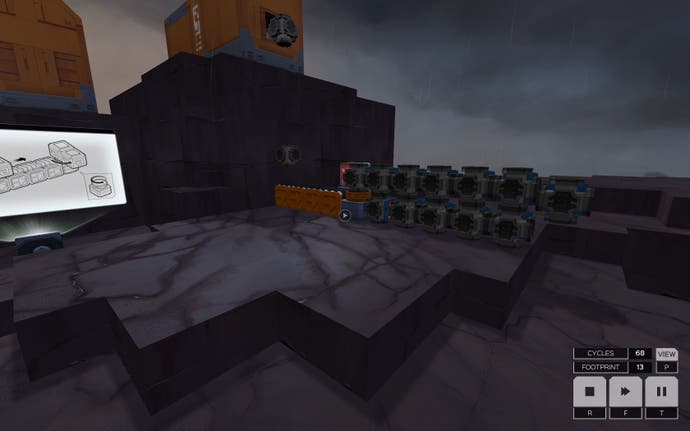Endless joy: Inside Infinifactory, the sandbox SpaceChem successor
Through the mansions of pain.
If you're happy to think of a conveyor belt as a unit of time, you're probably going to get on okay with Infinifactory. Actually, you're probably going to love it, because, grim and dehumanised as this follow-up to SpaceChem often is, it's also a profoundly loveable game. I love the squeal of victory that erupts when a solution suddenly presents itself, of course, but I also love the protracted groan when things go wrong in an unforeseen, hilarious, and yet entirely logical, manner. Most of all, I love the fact that my initial response to the unveiling of an impossible new puzzle - and they all look impossible at first - isn't that I want to lie down in another room and maybe eat a biscuit. It's that I want to start tinkering, because tinkering will get you going here, even in lieu of an actual plan.
Infinifactory is all about building machines that allow you to piece together the specific objects you'll need to clear specific challenges - and then transport those objects from the point of manufacture to the goal. Often, there is no single point of manufacture, and you're essentially constructing a production line on which things take shape as they move.
So far, so SpaceChem. Here, though, you're working in three dimensions, and on a far more human scale than SpaceChem allowed for. Factories replace reactors, and squat little chunks of utilitarian hardware fill in for atoms and molecules, This isn't just about terminology, either. With this shift in focus comes an unexpected boon.

Infinifactory's a lot more approachable than SpaceChem, I think, and this is largely down to the way it uses the UI and mechanics of building games like Infiniminer and Minecraft to really thrust you into its world. You move around the environment here in the first-person, and you select the pieces you can use from a familiar tray at the bottom of the screen.
These pieces are all pretty simple to get to grips with, too. Puzzles swiftly become pleasantly challenging, but the solution will always lie with the same handful of basic elements: conveyor belts to move pieces around, rotators to change their direction, welders to stick multiple pieces together with the brisk sizzle from a laser. Even when you're connecting push blocks with distant switches, it's still a very straightforward process, and the most complex design will take only a few minutes to build - at which point the fun of debugging begins.
Often, that debugging revolves around problems caused by the environment. A puzzle might task you with putting together a spaceship from three different parts, but the trick comes from the fact that those parts spawn in different locations and need to then be transported half-way across a map to a floating island that hovers at an entirely different height. It's not uncommon - not uncommon for me, anyway - to construct a complex unit from a range of modules, and then get it to the goal facing the wrong way.

Solving these sorts of problems - and others like it - are where the game really comes together. I've spent the last few hours using conveyor belt kinks to slow down certain modules so they arrive at welders at the right moment. A conveyor belt really can be a unit of time. I've also had to learn how to use standard blocks as pauses within a conveyor belt so that I can bunch modules together before they reach welders. This, of course, has lead to moments where I've ended up bunching all of my modules together, at which point the welders just go nuts, turning out an endless, inflexible sausage of metal that disappears into the distance. Infinifactory indeed.
Disasters like this are part of the fun. Every time you finish a design and start the fabricators going, you never know whether you've foreseen every logical output of your various garbled inputs. My favourite moment yet came when I laid down a conveyor belt that ground to a halt a few blocks short of its destination. The pieces trundling down the belt quickly started to stack at the end, and then the stacks themselves started to move forward. It was like mould spreading across the map. It felt alive.

Beyond such pleasures, Infinifactory also has a Portalesque narrative complete with dark Fordist humour and a holding cell where you're fed food pellets in between puzzles. More importantly, once each puzzle is completed, you get to see how your Steam friends have done - a neat little bit of SpaceChem-styled feedback that breaks a solution down into its footprint and the number of cycles it took, but hides the mystery of how these stats played out on the field. Such is the iterative approach Infinifactory cultivates that I've spent hours going back into old puzzles and making my factories more elegant. (Suffice it to say, if you're ever wondering whether you want me or Gamasutra's UK news editor Phill Cameron to mass-produce your rocket ships, you should probably still ask Phill.)
Speaking of elegance, although Infinifactory is pretty much feature complete as far as I can tell, it's labeled as an Early Access game because the developer plans on building upon the current framework, and also fine-tuning things. This is why a little survey pops up at the end of each level, asking you whether a puzzle was too tough, but also whether it was fun to complete. Mobilis in mobili: it all feels so appropriate. You're tested so that the tests themselves may get smarter. You're building for the benefit of those who build in your footsteps.








.jpg?width=291&height=164&fit=crop&quality=80&format=jpg&auto=webp)
_Rwmp6uD.jpg?width=291&height=164&fit=crop&quality=80&format=jpg&auto=webp)